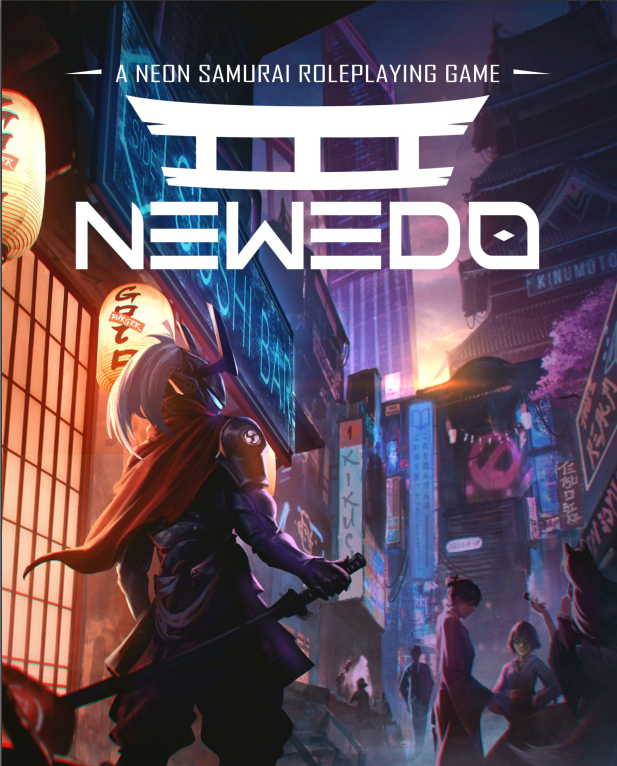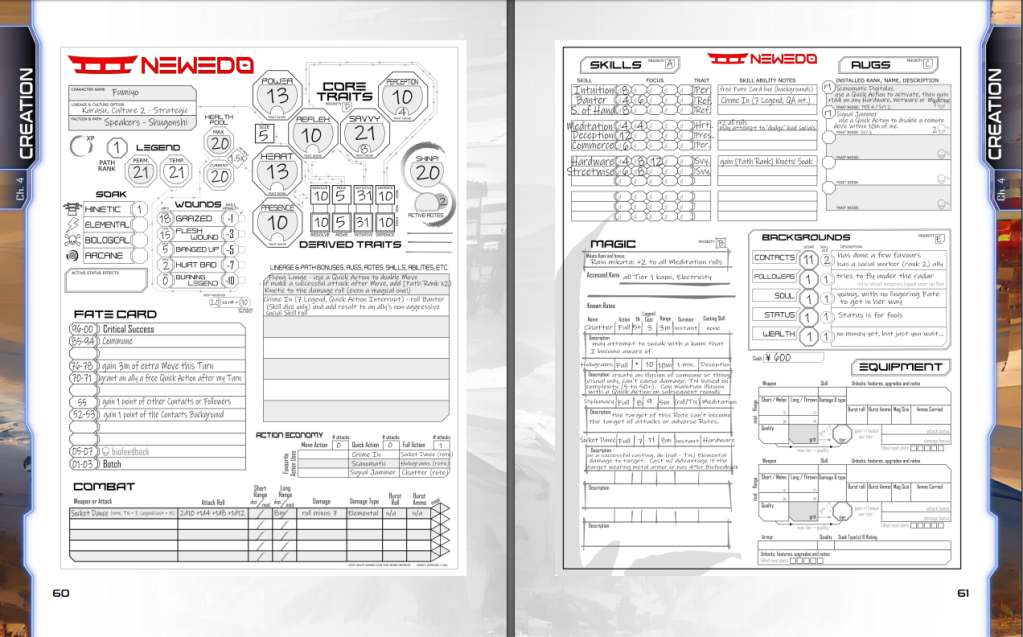
Joann and I have made no secret about our interest in new tabletop roleplaying games, both new to us in system or mechanics or new to us in setting and genre. We’ve also described many times and in many different forums how we initially met as a result of her posting and my looking for a Shadowrun game. It really should come as no surprise that a game like NewEdo by Salty Games piqued my interest. Described as a “Neon Samurai” roleplaying game, the name and the cover imagery evoke for me the cybered-up Street Samurai of Shadowrun, old Samurai anime like Rurouni Kenshin and Ninja Scroll, and attitude like Cowboy Bebop and perhaps William Gibson’s Sprawl Trilogy which starts out in a dystopian underworld named Chiba City in Japan that I’ve imagined looking somewhat like the cover only dingier.
Funded by Kickstarter on December 2, 2021, NewEdo, by Russ Rowlands, is a game about Legends with a capital ‘L’. The people that literally everyone has heard of, whose exploits are stories for generations. Set in the city of NewEdo where literally anything can happen if enough people believe it can, the players step from the shadows ready to give the people something new to believe in: You. You may come from different paths or lineages, you may have different skills and specialties. But you each burn to make a name for yourselves and firmly grip the minds and hearts of the people of NewEdo so that you too can live forever as a Legend.
Manufacturing & Production
We backed this at a time when we had to be a little more selective with the amount of money we were spending on Kickstarters. As a result, I only got the softcover, black-and-white edition of the book (though the cover is full-color). That said, it has held up quite well through a move since. The glue binding is of excellent quality with a nice, hefty cardstock cover. The printing is excellent with no noticeable smear on handling. Even in black-and-white, the images are crisp and clean and indicative of the attentiveness and dedication to an excellent product that Russ and his team have.
Regarding layout, the text blocks are easy to follow and the text itself is easy to read in both font and size. Although the included Character Sheet is busy and holds an exceptional amount of data, it still feels clean and usable. Additionally, this game has one of my favorite things that not all game designers use: a full character creation example with a filled-out character sheet showing how the fields and boxes are to be used in the context of a created character. I can’t even begin to tell you how much time I have scratched my head over a character sheet for a game while trying to figure out how the author intended that I use this box or another. If you design games, take a page from this book: Don’t make us guess anymore. Unless it’s ridiculously obvious, just put an example in.

Content
NewEdo, the Roleplaying Game falls somewhere in the middle of the spectrum of the mechanical (or crunch) and narrative spectrum of roleplaying games. I would probably shift this off-center toward the narrative end simply because of the sheer amount of narrative choices both in character creation and also the way doing “cool shit” is encouraged through the use of the Legend mechanic as a way that your character would get talked about more and your reputation would increase. A key component of character creation in NewEdo is developing a Legend for and around your character. As soon as you come up with a concept, begin to think about that character’s motivations, and why they get off the couch and go hustle in the city. As you proceed through character creation and refine your concept, consider how each of these choices may impact or even change your character’s motivation, their Legend.
First, you choose your Path (roughly analogous to a character class or type) and your Lineage (biological species/form). Tied to your path are Factions. NewEdo has seven Factions that offer 17 Path options, plus a further four Unaligned Paths. Some of the roles or playstyles supported by these various Paths overlap – many are highly capable fighters, for example. Each has its own style but should also be considered as part of its Faction when you’re deciding what kind of character you’d like to build. Faction allegiance makes your character a part of a machine that has ambitions beyond those of its individual members.
After that, you begin a priority buy system that can essentially customize any Path/Lineage combination to be effective in most if not all roles in a group. This priority buy system should be familiar to anyone who has ever played Shadowrun (as should the priority table on p. 58). The Priority choices are different, however, and in NewEdo they are: Backgrounds, Magic, Augs, Skills, and Core Traits.
“Your Path (and to some degree, Lineage) generally defines what you want to accomplish, and why. Your Priority choices better define how you go about actually getting stuff done.”
NewEdo, p. 58
If this is too complicated for an initial foray (which it might be depending on where in the TTRPG space you’re coming from), there are a handful of pre-generated characters helpfully included in the book for that purpose.
Skills, on the other hand, while similar to Shadowrun and games like World of Darkness which add to an attribute to give a dice pool, do so differently. Instead of a common die (d6 or a d10 in those two games respectively), skill dice that are added can be d4, d6, d8, or d12. You can have a skill rank from 0 to 5 and your rank is the number of dice you roll for a skill check. Each rank on the character sheet holds the descriptor for a die. The term Focus describes how “big” the die is (d6 being “bigger” than d4, etc.). Once chosen, the only way an existing focus die can be upgraded is if you are already a Rank 5 in that skill (the theory being that you have to be a master in your skill before you understand fully how any shortcuts you have taken have hurt your form). You can increase your rank in a given skill, but the cost increases exponentially with the “bigness” of the Focus.
Skill checks, then are done by creating a dice pool from a Core Trait (using the value as a number of d10s to roll) plus a skill (using the rank dice of the skill – if any – as additional dice). The numbers on the dice are ADDED together (and the Core Trait dice use exploding 10s – if a dice rolls 10, you add 10 to that total and roll that dice again for an additional value until you stop rolling 10s). Before this, however, you must Roll your Fate (something that happens once per round during an active challenge – combat or otherwise). This is a percentile mechanic that adds an additional layer of randomness to the results of a given situation. Each character begins with a basic Fate Card and a line determined by the character’s chosen Path. But there are many ways to add to a Fate Card in NewEdo (every Path and many Skills add to or change the percentile numbers on your Fate Card as you advance in them).
Like many cyberpunk games, augmentations and equipment abound offering customization and lethality in equal abundance. This game also has magic (like Shadowrun), which is described as a language most people cannot hear known as Shinpi that allows one to have a broader relationship with the Japanese Kami from which all magic flows. These allow the user to cast Rotes (which are “codified” magical interactions with the Kami) that are based on a massive amount of Kami aspects (things and ideas).
Advancement is handled through increases in Legend and XP. Augments are purchased as is any other new equipment or vehicle your little cyber heart desires. Core Traits, Backgrounds, and Skills can all be advanced using XP. Shinpi can be increased like Core Traits but must be done in collaboration with the storyteller and with a story reason (if developed outside your Path).
There is also a chapter on Storytelling in NewEdo that offers some advice for new storytellers in running games using this system/setting. Some of the advice is generic and similar to many other games, and some of it is both specific and useful to this one. It also discusses Character rewards and death. There are appendixes at the end that discuss the creation of pets, give more vehicular options, and give additional NPCs of NewEdo for your players to meet.
Critique
The only critique I have is that I would love to see more setting in this book and possibly an “introductory” adventure to give new NewEdo (that’s kind of a mouthful) storytellers something more to build off of. One of the things I know I personally struggle with is coming up with campaign/adventure/encounter ideas wholesale. But if someone gives me a tidbit, something to riff off of, I can expand it. Now, with that being said, seeds are coming. Salty Games just finished another successful Kickstarter called 77 Stories in NewEdo which is a book of story seeds. I’d probably still want a more “setting”-focused book (maps, districts, a few buildings with some detail and layout maps – something to give more of a “feel” for the area, but I’m sure we haven’t seen the last of Salty Games either.
Summary
NewEdo is a tabletop roleplaying game by Russ Rowlands of Salty Games. A medium-complexity cyberpunk game, it blends some unique narrative concepts along with some new twists on mechanical ones to offer an option-heavy sandbox to tell your high-octane Neon Cyberpunk stories. The high production value of the book as well as the different feel of the setting from similar more traditional dystopian cyberpunk games offers a new vantage point from which to re-look at this genre. We would absolutely recommend checking this out. You can find it at DriveThruRPG. I know it’s been a while, but we’re still here, we’re still playing and checking out new games, both those we back and otherwise. So from our Citadel to yours, Happy Gaming!
- Josh Walles
